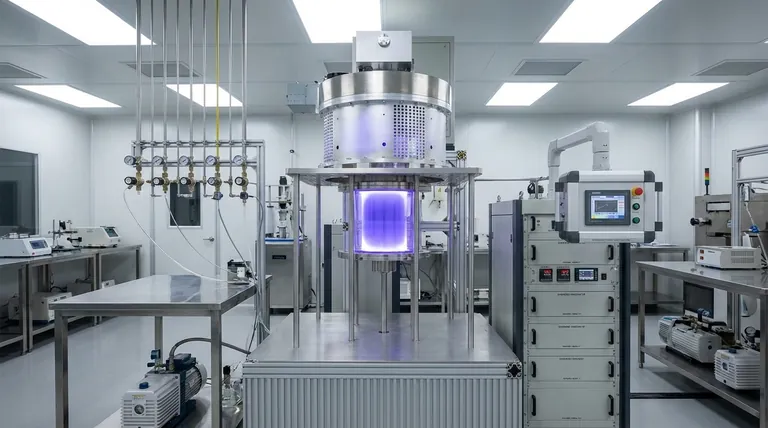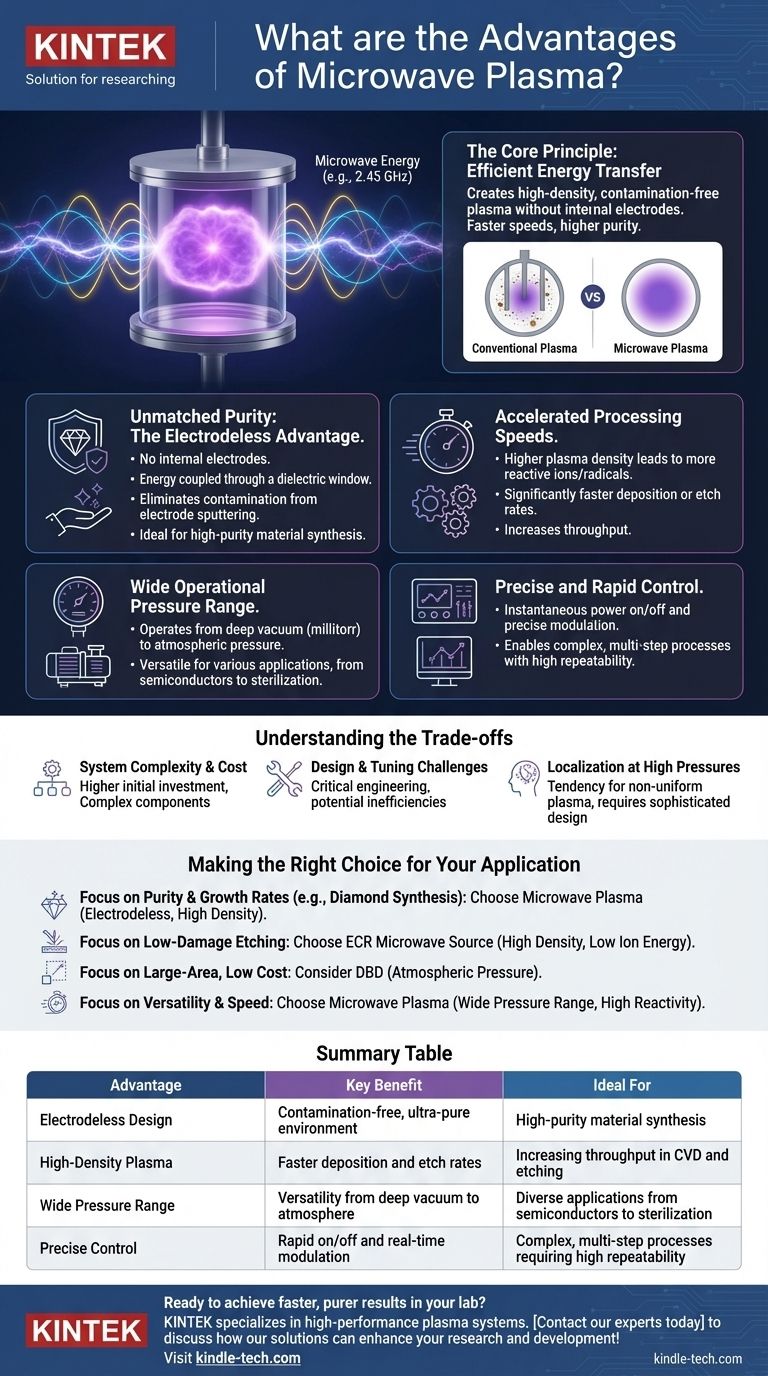The fundamental advantage of microwave plasma is its ability to create a high-density, contamination-free plasma with exceptional efficiency. Unlike other methods, it uses microwave energy to ionize a gas without internal electrodes, which directly translates to faster processing speeds, higher purity outcomes, and a wider operational range for demanding applications.
While many methods can create plasma, microwave plasma excels by efficiently generating a high density of reactive species without internal electrodes. This unique combination leads to faster process speeds and higher purity results, making it the superior choice for high-performance applications.

The Core Principle: Efficient Energy Transfer
At the heart of microwave plasma's benefits is how it transfers energy. By using high-frequency electromagnetic waves (typically 2.45 GHz), it can efficiently energize electrons within a gas, leading to a cascade of ionization.
Creating High-Density Plasma
Microwave frequencies are uniquely effective at accelerating electrons in a gas. This efficient energy transfer creates a much higher density of free electrons and ions (often 100 to 1000 times more) compared to conventional DC or radio-frequency (RF) plasmas. This high density is the source of its primary performance benefits.
Volumetric and Uniform Generation
Because microwaves can penetrate the entire volume of the gas, they create a plasma that is not confined to the area near an electrode. This results in a more uniform and stable plasma discharge throughout the reactor, ensuring consistent treatment of any material placed within it.
Key Operational Advantages
The unique physics of microwave plasma generation leads to several critical advantages in practice, moving beyond simple heating to advanced material processing.
Unmatched Purity: The Electrodeless Advantage
This is arguably the most critical advantage. Microwave plasma systems are electrodeless, meaning the energy is coupled into the gas through a dielectric window (like quartz). There are no metal electrodes inside the chamber that can be sputtered by ion bombardment, which is a common source of contamination in other plasma systems. This guarantees an ultra-pure process environment.
Accelerated Processing Speeds
A higher density of plasma means a higher concentration of the reactive ions and radicals that do the work. For applications like chemical vapor deposition (CVD) or etching, this directly results in significantly faster deposition or etch rates, reducing overall processing time and increasing throughput.
Wide Operational Pressure Range
Microwave plasma can be sustained over an exceptionally broad pressure range, from deep vacuum (millitorr) to atmospheric pressure. This versatility allows it to be adapted for a vast array of tasks, from high-purity semiconductor fabrication at low pressure to rapid surface sterilization at atmospheric pressure.
Precise and Rapid Control
Modern microwave power supplies offer exquisite control over the plasma. The power can be turned on and off almost instantaneously and can be precisely modulated. This allows for fine-tuning of plasma characteristics in real-time, enabling complex, multi-step processes with high repeatability.
Understanding the Trade-offs
No technology is without its limitations. Objectivity requires acknowledging where microwave plasma might not be the best fit.
System Complexity and Cost
Microwave plasma generators, waveguides, and impedance-matching networks are generally more complex and expensive than simpler DC or low-frequency RF systems. The initial capital investment is higher.
Design and Tuning Challenges
Properly designing a microwave plasma reactor and ensuring efficient power coupling (impedance matching) is a non-trivial engineering task. Poor design can lead to reflected power, inefficient plasma generation, and standing waves that create non-uniformities.
Localization at High Pressures
While microwave plasma can operate at atmospheric pressure, it has a natural tendency to constrict into a narrow, filament-like column. Achieving a large-area, uniform plasma at high pressure requires sophisticated reactor designs, which can add to the system's complexity.
Making the Right Choice for Your Application
The decision to use microwave plasma should be driven by your primary technical goal.
- If your primary focus is material purity and high growth rates (e.g., diamond synthesis): The electrodeless nature and high plasma density make microwave plasma the definitive choice.
- If your primary focus is low-damage etching of sensitive substrates: An Electron Cyclotron Resonance (ECR) microwave source is ideal, as it creates high-density plasma with low ion energy.
- If your primary focus is large-area surface treatment at the lowest possible cost: Simpler technologies like atmospheric-pressure dielectric barrier discharge (DBD) may be more economical.
- If your primary focus is process versatility and speed: The wide pressure range and high reactivity of microwave plasma offer a powerful and flexible platform.
Ultimately, leveraging microwave plasma is a decision to prioritize performance—achieving faster, purer, and more controlled results in demanding applications.
Summary Table:
| Advantage | Key Benefit | Ideal For |
|---|---|---|
| Electrodeless Design | Contamination-free, ultra-pure environment | High-purity material synthesis (e.g., diamond) |
| High-Density Plasma | Faster deposition and etch rates | Increasing throughput in CVD and etching |
| Wide Pressure Range | Versatility from deep vacuum to atmosphere | Diverse applications from semiconductors to sterilization |
| Precise Control | Rapid on/off and real-time modulation | Complex, multi-step processes requiring high repeatability |
Ready to achieve faster, purer results in your lab?
KINTEK specializes in high-performance lab equipment, including advanced plasma systems. Our expertise can help you leverage the power of microwave plasma for your most demanding applications in material synthesis, surface treatment, and semiconductor processing.
Contact our experts today to discuss how our solutions can enhance your research and development!
Visual Guide

Related Products
- 915MHz MPCVD Diamond Machine Microwave Plasma Chemical Vapor Deposition System Reactor
- Microwave Plasma Chemical Vapor Deposition MPCVD Machine System Reactor for Lab and Diamond Growth
- Cylindrical Resonator MPCVD Machine System Reactor for Microwave Plasma Chemical Vapor Deposition and Lab Diamond Growth
- Chemical Vapor Deposition CVD Equipment System Chamber Slide PECVD Tube Furnace with Liquid Gasifier PECVD Machine
- Inclined Rotary Plasma Enhanced Chemical Vapor Deposition PECVD Equipment Tube Furnace Machine
People Also Ask
- What is the microwave plasma method? A Guide to High-Purity Material Synthesis
- How difficult is it to grow a diamond? The Immense Challenge of Atomic-Level Precision
- How does MPCVD work? A Guide to Low-Temperature, High-Quality Film Deposition
- What is MPCVD? Unlock Atom-by-Atom Precision for High-Purity Materials
- What is microwave plasma CVD? A Guide to High-Purity Diamond and Material Synthesis



















